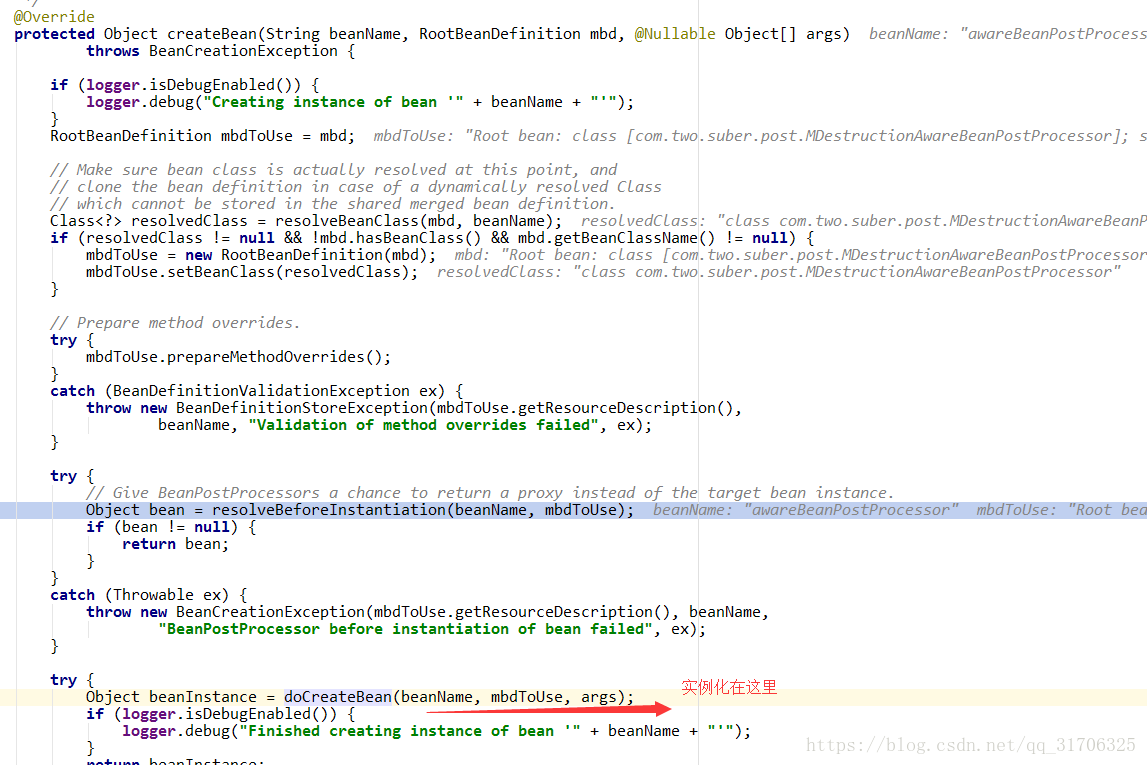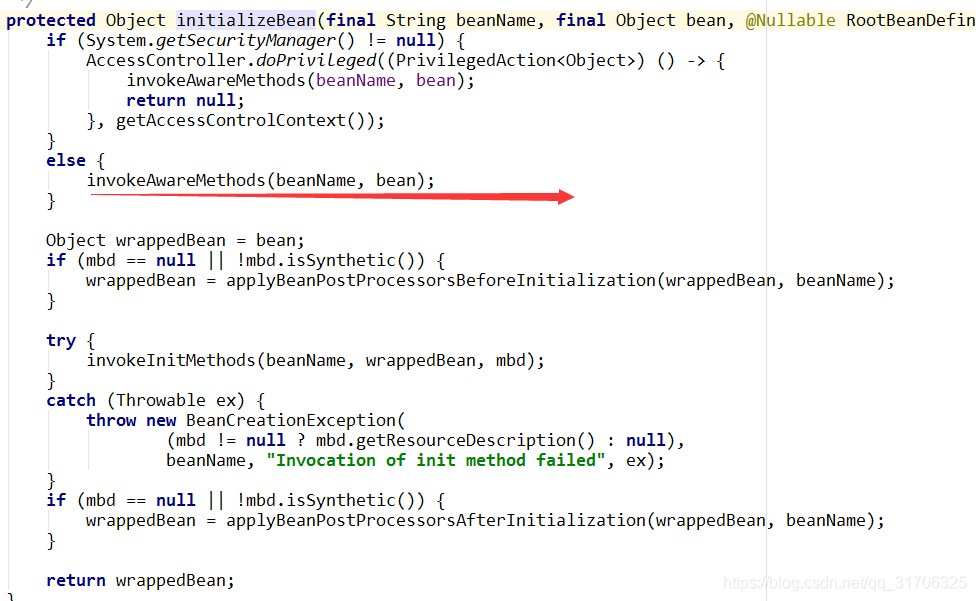淺談Spring中幾個PostProcessor的區別與聯系
按照執行的順序,可以分為以下幾個步驟:
BeanDefinitionRegistryPostProcessor 是在注冊 Bean 定義信息前后調用;
BeanFactoryPostProcessor 是在創建 Bean 前后調用;
BeanPostProcessor 是在初始化 Bean 前后調用;
其中 BeanDefinitionRegistryPostProcessor 是 BeanFactoryPostProcessor 的子類,所以可以使用前者代替后者實現功能。
查看 IOC 容器創建時的調用流程refresh 方法的代碼如下:
// Allows post-processing of the bean factory in context subclasses.postProcessBeanFactory(beanFactory);// Invoke factory processors registered as beans in the context.invokeBeanFactoryPostProcessors(beanFactory);// Register bean processors that intercept bean creation.registerBeanPostProcessors(beanFactory);// Initialize message source for this context.initMessageSource();// Initialize event multicaster for this context.initApplicationEventMulticaster();// Initialize other special beans in specific context subclasses.onRefresh();// Check for listener beans and register them.registerListeners();// Instantiate all remaining (non-lazy-init) singletons.finishBeanFactoryInitialization(beanFactory);// Last step: publish corresponding event.finishRefresh();
其中的 invokeBeanFactoryPostProcessors 就執行了注冊定義信息和創建 Bean 的方法;而 finishBeanFactoryInitialization 執行了初始化 Bean 的方法。
具體的執行順序大家可以自行打斷點調試,由于涉及的源碼過多,這里不再展示。
spring-postProcessor的執行時機spring bean 的生命周期粗糙的分為以下步驟。
實例化(創建一個屬性都為空的對象)---------》屬性填充(populateBean,下文中這個步驟我都稱為初始化)-----------》init方法的執行(invokerInitMethods,下文稱為init)
postprocessor的方法就是穿插在這三個大的步驟中。
BeanPostProcessor:
postProcessBeforeInitialization調用時機

向上找調用者:

繼續向上:

看以看出populateBean(初始化bean)-------------------》beanpostBeforeInitialization---------------------------------->invokeinitMethods(配置的init-method)
postProcessAfterInitialization調用時機:
向上:

可以看出在init-method方法之后
看以看出populateBean(初始化bean)-------------------》beanpostBeforeInitialization---------------------------------->invokeinitMethods(配置的init-method)------->postProcessAfterInitialization
public class MBeanPostProcessor implements BeanPostProcessor { @Override //populateBean之后 invokeinitMethods之前 public Object postProcessBeforeInitialization(Object bean, String beanName) throws BeansException {System.out.println('post bean before! :'+beanName);return bean; } @Override //invokeinitMethods之后 public Object postProcessAfterInitialization(Object bean, String beanName) throws BeansException {System.out.println('post bean after!'+beanName);return bean; }}
另一個重要的是:
InstantiationAwareBeanPostProcessor
postProcessBeforeInstantiation調用時機:

向上找調用者:

繼續向上:

可以看出是在實例化之前:(也就是反射創建對象之前,如果postProcessBeforeInstantiation創建了一個非空的對象,則不會走實例化步驟。)
postProcessAfterInstantiation調用時機:
protected void populateBean(String beanName, RootBeanDefinition mbd, @Nullable BeanWrapper bw) { PropertyValues pvs = mbd.getPropertyValues(); if (bw == null) { if (!pvs.isEmpty()) { throw new BeanCreationException( mbd.getResourceDescription(), beanName, 'Cannot apply property values to null instance'); } else { // Skip property population phase for null instance. return; } } // Give any InstantiationAwareBeanPostProcessors the opportunity to modify the // state of the bean before properties are set. This can be used, for example, // to support styles of field injection. boolean continueWithPropertyPopulation = true; if (!mbd.isSynthetic() && hasInstantiationAwareBeanPostProcessors()) { for (BeanPostProcessor bp : getBeanPostProcessors()) { if (bp instanceof InstantiationAwareBeanPostProcessor) { InstantiationAwareBeanPostProcessor ibp = (InstantiationAwareBeanPostProcessor) bp; //在這里執行 if (!ibp.postProcessAfterInstantiation(bw.getWrappedInstance(), beanName)) { continueWithPropertyPopulation = false; break; } } } } if (!continueWithPropertyPopulation) { return; } 省略。。。。。 applyPropertyValues(beanName, mbd, bw, pvs);}
可以看出是在在初始化之前,具體是屬性填充之前。(初始化之前,實例化之后) 如果返回fales,則不會繼續初始化,即不會屬性填充。
postProcessPropertyValues調用時機:
protected void populateBean(String beanName, RootBeanDefinition mbd, @Nullable BeanWrapper bw) { PropertyValues pvs = mbd.getPropertyValues(); if (bw == null) { if (!pvs.isEmpty()) { throw new BeanCreationException( mbd.getResourceDescription(), beanName, 'Cannot apply property values to null instance'); } else { // Skip property population phase for null instance. return; } } // Give any InstantiationAwareBeanPostProcessors the opportunity to modify the // state of the bean before properties are set. This can be used, for example, // to support styles of field injection. boolean continueWithPropertyPopulation = true; if (!mbd.isSynthetic() && hasInstantiationAwareBeanPostProcessors()) { for (BeanPostProcessor bp : getBeanPostProcessors()) { if (bp instanceof InstantiationAwareBeanPostProcessor) { InstantiationAwareBeanPostProcessor ibp = (InstantiationAwareBeanPostProcessor) bp; if (!ibp.postProcessAfterInstantiation(bw.getWrappedInstance(), beanName)) { continueWithPropertyPopulation = false; break; } } } } if (!continueWithPropertyPopulation) { return; } if (mbd.getResolvedAutowireMode() == RootBeanDefinition.AUTOWIRE_BY_NAME || mbd.getResolvedAutowireMode() == RootBeanDefinition.AUTOWIRE_BY_TYPE) { MutablePropertyValues newPvs = new MutablePropertyValues(pvs); // Add property values based on autowire by name if applicable. if (mbd.getResolvedAutowireMode() == RootBeanDefinition.AUTOWIRE_BY_NAME) { autowireByName(beanName, mbd, bw, newPvs); } // Add property values based on autowire by type if applicable. if (mbd.getResolvedAutowireMode() == RootBeanDefinition.AUTOWIRE_BY_TYPE) { autowireByType(beanName, mbd, bw, newPvs); } pvs = newPvs; } boolean hasInstAwareBpps = hasInstantiationAwareBeanPostProcessors(); boolean needsDepCheck = (mbd.getDependencyCheck() != RootBeanDefinition.DEPENDENCY_CHECK_NONE); if (hasInstAwareBpps || needsDepCheck) { PropertyDescriptor[] filteredPds = filterPropertyDescriptorsForDependencyCheck(bw, mbd.allowCaching); if (hasInstAwareBpps) { for (BeanPostProcessor bp : getBeanPostProcessors()) { if (bp instanceof InstantiationAwareBeanPostProcessor) { InstantiationAwareBeanPostProcessor ibp = (InstantiationAwareBeanPostProcessor) bp; pvs = ibp.postProcessPropertyValues(pvs, filteredPds, bw.getWrappedInstance(), beanName); if (pvs == null) { return; } } } } if (needsDepCheck) { checkDependencies(beanName, mbd, filteredPds, pvs); } } applyPropertyValues(beanName, mbd, bw, pvs);}
在postProcessAfterInstantiation之后,applyPropertyValues之前。(屬性填充之前修改屬性值)
總結: 執行順序 1.postProcessBeforeInstantiation(實現這個方法可以做自定義實例化) 2.實例化 3.postProcessAfterInstantiation(是否要初始化) 4.postProcessPropertyValues(修改屬性) 5.初始化(屬性填充)(populateBean) 6.postProcesstBeforeInitialization( 自定義init方法執行之前) 7.invokeinitMethods(執行自定義的init方法) 8.postProcessAfterInitialization(自定義init方法執行之后)如果加上aware

以上為個人經驗,希望能給大家一個參考,也希望大家多多支持好吧啦網。
相關文章:
1. 詳解JSP 內置對象request常見用法2. ASP.NET MVC實現下拉框多選3. ASP.NET MVC增加一條記錄同時添加N條集合屬性所對應的個體4. .NET Framework各版本(.NET2.0 3.0 3.5 4.0)區別5. 解決request.getParameter取值后的if判斷為NULL的問題6. JSP中param動作的實例詳解7. ASP.NET MVC實現本地化和全球化8. .Net反向代理組件Yarp用法詳解9. JS中的常見數組遍歷案例詳解(forEach, map, filter, sort, reduce, every)10. .NET中的MassTransit分布式應用框架詳解

 網公網安備
網公網安備